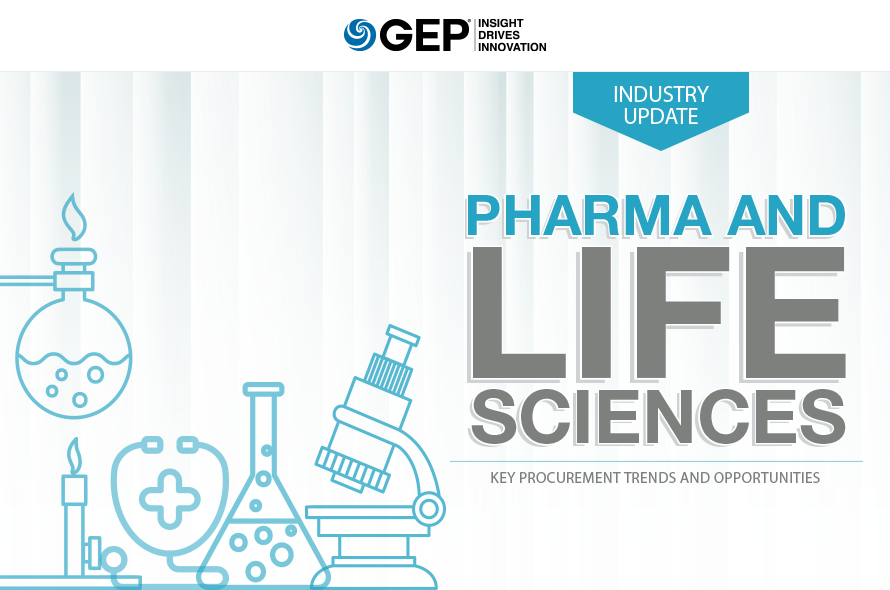Rising cost pressures, government regulations, patent expirations, growing patient demands — pharma and life sciences companies confront a host of challenges. Yet the best-in-class companies are finding newer ways — be it through M&A, leveraging data analytics, or focusing on specialty drugs — to remain profitable. Regulatory reforms and advances in science and technology are enabling them to innovate and move forward.
What are the latest macroeconomic trends impacting the pharma and life sciences industries? And what do they mean for your business, and the procurement function? Our latest white paper, Pharma and Life Sciences: Key Procurement Trends and Opportunities, explains. It discusses the broader industry outlook — focusing on primary factors including scientific disruptors, macro-economic trends and performance catalysts — and also underlines the important role of procurement in improving a company’s strategic positioning.
A must-read for all pharma and life sciences professionals looking to understand the current industry trends and achieve sustainable growth.
Introduction: An Industry Outlook
It’s an ironic situation: Companies that focus their entire mission on improving people’s health and well-being are battling for their own health and success in an intensified risk environment. Organizations are striving to achieve sustainable growth and increasing revenues amid the pressures of rising costs, regulatory hurdles and policy shifts. Executives continue to explore innovative options in growing the business model. The demand for specialty drugs is at an
all-time high, yet research remains an elevated expense. Companies across the board are increasing their operational efficiency and cross-functional data sharing within the organization — and involving procurement organizations to help increase the indirect value addition to organizational annual revenues.
Life sciences companies have seen a trend of market-related socioeconomic uncertainty that has led to inhibitions in initiating and implementing growth-related strategies. However, significant progress within the regulatory, scientific and technology fields has paved the way for companies to prepare for new growth opportunities.
The life sciences industry is expecting possible instability in patient/consumer demand and innovative technologies that could change industry dynamics. Technological advancements are accelerating opportunity versus risk assessment scenarios. The outlook today for the life sciences industry is positive, with a focus on primary factors under scientific disruptors, macroeconomic trends and performance catalysts.
Scientific Disruptors
a. Growing Demand for Specialty Drugs: Prices of prescription drugs have been relatively low compared to the overall health care cost trend. This pattern, however, is set to reverse, primarily due to the production and utilization of specialty drugs. Focusing on specialty drugs will prove to be highly rewarding for companies, as these drugs will be more expensive due to less competition and fewer ongoing existing treatments. However, undertaking research and development (R&D) will become very important, with a significant focus on speed-to-end-users and IP protection.

Implications for Procurement: Most of the drug development will take place through external partners. Procurement will play a critical role not just in the selection of the right partners, but also in establishing robust processes to manage suppliers and mitigate risks related to IP protection, while supporting speed-to-market through fast decisions and rapid partner selection.
b. Advanced Technologies: Artificial intelligence will be the key catalyst in helping life sciences companies achieve competitive R&D goals targeted in the future. Forecasting data analytics combined with automation will enable creativity in discovery, as well as a focus on precision medicine and addressing productivity challenges. Data science and statistical tools, combined with automation, will enable companies to overcome marketing challenges and reach end users at a faster rate. A significant portion of the budget will be allocated for investments in emerging technologies, and companies should try to adopt such technologies across every function within their organization.
Implications for Procurement: Now more than ever, procurement’s role is not just to improve the bottom line and mitigate risk (operational, information security and personal data); it needs to look inward and forward. The two main priorities are: 1) How to ideate, deploy and implement these technologies enterprise-wide, and 2) how to use them to improve procurement’s practices, processes and policies.
c. Endorsing Innovation : Over the years, life sciences companies have faced increasing pressure from end users, investors and pay channel stakeholders to discover therapies for curing life-threatening diseases. To reduce cycle times in launching new products, organizations are now leveraging data analytics and innovative ideas that are leading to improved decision making, more patient-focused research, improved stakeholder partnerships, and conversion of identified results into practice. This innovative, data-based decision-making process can help to personalize care, provide enhanced services to patients, and promote collaboration with other stakeholders in the system. Life sciences companies are investing to make patient experience a strategic focus area, not just resorting to a software platform to stay ahead of the competition.
Implications for Procurement: Smart product development requires specialization and expertise in wide-ranging fields. Procurement should identify partners, alliances and other collaborative opportunities to acquire the capabilities and expertise it needs to develop next- generation “smart” devices.
Macroeconomic Trends
a. Larger Merger & Acquisition Deals The pharmaceutical industry witnessed a huge jump in mergers and acquisitions (M&A) in the first quarter of 2018, with roughly $156 billion in deals involving pharma giants including Sanofi, GlaxoSmithKline and Celgene. Over the next 10 years, $17 billion worth of patents for the big, blockbuster drugs are expected to expire. The major players need to find a way to make up for that lost revenue. Developing new drugs is an expensive and timely endeavor, and outcomes are uncertain. While R&D will continue to remain a focus area, more pharmaceutical companies are likely to grow through acquisition. Large market capitalization companies are expected to purchase smaller pharmaceutical players that already have profitable drugs in the pipeline. The big companies can help accelerate the growth of these smaller ones through marketing, rebranding, production and distribution efficiencies, and label expansions.

Implications for Procurement: Apart from revenue drivers, cost reduction becomes a major component of M&A and is a key expectation from markets. Procurement-related savings are typically the largest contributors to such acquisitions. Procurement needs to be quick to implement supplier and volume consolidation, update category strategies and drive cost savings through synergies in the supply base. With M&A dollar-volumes increasing, big pharma companies will have an even greater volume leverage and buying power over suppliers.
b. Developments in Regulation Regulatory changes are expected to increase investments in drugs that cure rare diseases. Also, the U.S. Food & Drug Administration (FDA) has been authorized to accelerate the approval process for such drugs in 2018. Real World Data (RWD) collected through electronic health records (EHRs), patient billing patterns and health monitoring devices provide valuable information on the usage, benefits and risks of a medical product. The FDA uses this data and other evidence to track safety and adverse events, draft regulator and coverage decisions, and prepare guidelines and decision support tools for use in clinical practice. Life sciences companies also use this data to support clinical trial designs and discover new therapeutic methods. The 21st Century Cures Act passed by the U.S. Congress in 2016 supports these changes.
Implications for Procurement: Procurement teams need to explore and stay updated on all the tools available in the market — such as analytics, feedback mechanisms from procurers and consumers, evidence-based research findings, etc. — to help businesses improve products, grow revenues, and comply with current and emerging regulations.
c. Socioeconomic Changes: The continuing focus on reducing health care costs will be one of the key points in discussions related to economic policies. Health care system reforms and remodeling will continue to be tested in the future. Legislative pressures on tax reform for life sciences companies will enable more growth-influencing strategies between life sciences firms. Increased investments within the U.S. due to reduced corporate taxes, introduction of new taxes, higher spend by firms within the U.S., taxes of repatriated foreign income from intangible assets, and chances of repealing the estate tax affecting philanthropic contributions could be expected in the future.
Implications for Procurement: Being aware of legislative, technological, scientific or regulatory risks is different from being prepared to respond to them, and the best-prepared procurement teams could have a competitive advantage. Within a life sciences company, people in regulatory affairs, business development, product development, R&D or manufacturing may not necessarily work together or share information. Procurement teams need to take the lead in coordinating between the functions, particularly when it comes to improving a company’s strategic positioning — that’s called strategic risk management.
Performance Catalysts
a. Metrics-Based Evaluation: Relationships between pharmaceutical companies and end users are generally measured using reduction in cost and cycle times. Cost of goods sold and cycle times/development times help to evaluate supplier-enabled innovations and risk-mitigating partnerships with customers. Risk mitigation is also measured by the level of transparency the supplier shows in sourcing of materials and services. Success factors are also measured through diversity metrics, goals related to sustainability in contracts and ethical practice compliance procedures. The key trends going forward will be to effectively measure supplier risk, traceability and transparency in the supply chain and supplier-driven innovation, and meet the sustainable risk-mitigation goals. The procurement function needs to focus more on the quality and quantity of these metrics to enable greater traction in pursuit of the functional goals and overall organizational value generated.

Implications for Procurement: Leading procurement organizations are already implementing metrics beyond cost reduction with their strategic suppliers. Procurement, as owners of strategic supply relationships, will be expected to establish, agree and measure the above key business metrics with strategic suppliers.
b. Analytics and Data Sciences Influence: The early adoption of analytics and advanced data sciences is critical for making business decisions across the value chain. Innovation has played a significant role in setting the trends for life sciences companies. Data analytics and data sciences have helped to realize real benefits from this evolving data ecosystem by evaluating data sets widely available in cloud-based storage and distributed computing power platforms. Proactive adaptation will help to map a patient’s drug usage patterns, optimize manufacturing capability and facilitate the regulatory process, generate market intelligence for identifying targeted users and improve supply chain capabilities. However, having the right leadership will be critical to ensure that the above benefits are realized through developing a formidable team on the ground at an early stage with strong compliance practices and auditing.
Implications for Procurement: Procurement teams will need to support organizations in identifying the right analytics partner to drive analytics-based decision making. With its access to the external services world, procurement is in the right position to advise businesses on the best practices in managing and driving decisions based on data analytics.
c. Predicting and Managing Risk: As life sciences firms continue to evolve in a highly competitive and dynamic situation, the factors critical to their success will be technology dependence, an increasingly diverse global customer base, and accelerated M&A activities. Growing complexities in the supply chain have increased the need for organizations to improve their risk management capabilities. Over the past few years, several compliance risks have been reported with companies increasingly relying on third parties to manage their day-to-day operations in most of the function. This makes the industry vulnerable to reputational and legal risks which, coupled with ensuing cost pressures, are posing greater challenges for procurement professionals. Implementation of sustainable risk measurement and mitigation strategies can be assessed as a key success factor in accelerating the growth and revenue trajectory for life sciences firms.
Implications for Procurement: Risk management is becoming a critical area for procurement organizations in life sciences companies. Establishing audit processes, risk management protocols and periodic reviews for these will become important focus areas for procurement as they support overall business risk management.
d. Value-Based Contracting: Analyzing a value-based contract necessitates weighing potential benefits and risks related to the company’s capabilities and resources. Stakeholder engagement, visibility, accountability and metrics measurement are key aspects in companies striking deals with health plans, providers or government payers. With challenges expected, leaders who prioritize the value imperative are shifting their organizations toward performance-based risk arrangements. Benefits include agreement of compensation with quality and improved administrative delivery efficiencies. Value-based contracting is critical for life sciences companies to establish themselves in the market. Leaders need to assess the implementation risk in order to avoid any impact on an organization’s overall growth strategy and market base.
Implications for Procurement: By working closely with legal and business stakeholders, procurement will need to more strongly emphasize value-based contracting for key suppliers that are directly involved in manufacturing and R&D. For high-value, high-cost treatments, some value-based contracting models could amortize costs over a longer timeline.
Conclusion
Within a life sciences company, leaders across different functions have to work together or share information to improve the company’s strategic positioning in the market. Given recent events and significant hurdles the life sciences industry has had to overcome, these key trends do reveal that there is light at the end of the tunnel. At the core, these issues show us how to improve and plan for a better tomorrow — by optimizing and consistently innovating. Understanding these parameters, from the socioeconomic macro level to their immediate impact on the life sciences industry, is the best guidance we have in our effort to create a better future for the industry.

